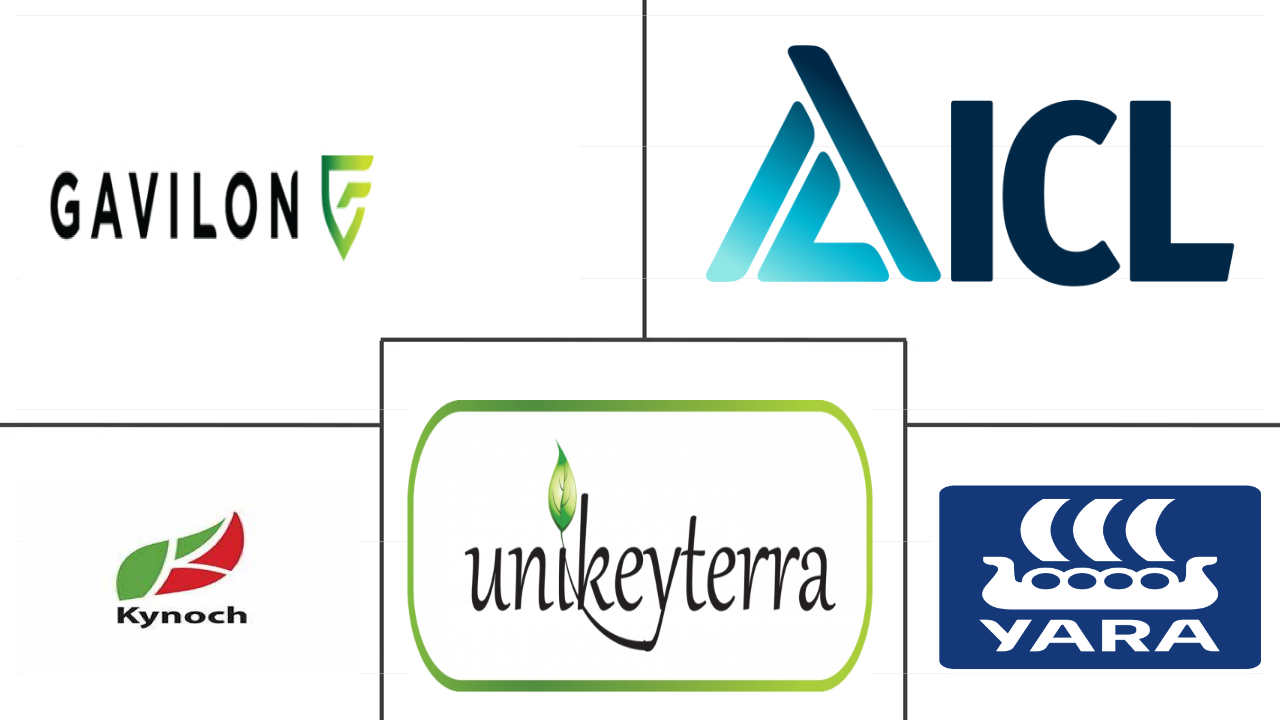Market Size of middle east & africa micronutrient fertilizer Industry
| Icons | Lable | Value |
|---|---|---|
|
|
Study Period | 2017 - 2030 |
|
|
Market Size (2024) | USD 263 Million |
|
|
Market Size (2030) | USD 404.1 Million |
|
|
Largest Share by Product | Zinc |
|
|
CAGR (2024 - 2030) | 7.42 % |
|
|
Largest Share by Country | South Africa |
Major Players |
||

|
||
|
*Disclaimer: Major Players sorted in no particular order |
Middle East & Africa Micronutrient Fertilizer Market Analysis
The Middle East & Africa Micronutrient Fertilizer Market size is estimated at 263 million USD in 2024, and is expected to reach 404.1 million USD by 2030, growing at a CAGR of 7.42% during the forecast period (2024-2030).
263 Million
Market Size in 2024 (USD)
404.1 Million
Market Size in 2030 (USD)
2.56 %
CAGR (2017-2023)
7.42 %
CAGR (2024-2030)
Largest Segment by Type
33.98 %
value share, Zinc, 2023
Most of Soils of Middle east and Africa are deficient in Zinc, and its application is proven to increase the yields and grain size, making it the most consumed micronutrient.
Fastest Growing Type
8.76 %
Projected CAGR, Molybdenum, 2024-2030
The pH of the soil is a major factor that decides the availability of molybdenum to the plant and is less availble in low PH soils which are predominant in sub saharan Africa.
Largest Segment by Crop Type
73.51 %
value share, Field Crops, 2023
Shifting focus toward balanced nutrition, increasing area under field crops, and need to maintain micronutrient levels in the soil for the proper growth may drive the market
Largest segment by Country
23.09 %
value share, South Africa, 2023
Micronutrient deficiencies have been reported in wide range of soils under differing crop production conditions in South Africa and zinc is most deficient micronutrient.
Leading Market Player
17.61 %
market share, Yara International ASA, 2022

Yara International emerged as a market leader by focussing on product innovations like Yaraprocote a coated micronutrient fertilizer which reduces nutrient losses upto 32%.
Demand for micronutrient fertilizers is growing due to increasing nutrient deficiency
- The micronutrient market in the region is projected to witness robust growth, with an estimated CAGR of 7.3% between 2023 and 2030. Notably, deficiencies of iron and zinc in plants are on the rise in the region, amplifying the demand for micronutrient fertilizers to bolster plant health.
- In 2022, zinc and iron dominated the market, accounting for 31.4% and 23.9% of the market value, respectively. These micronutrients are crucial for plant growth, and their deficiencies in soil have been linked to lower crop yields. Over the past decade, iron and zinc deficiencies in soils have been the primary drivers of the growth of the market.
- Micronutrient deficiencies are commonly observed in intensively cultivated crops like cereals, oilseeds, pulses, and vegetables. Consequently, farmers are increasingly turning to micronutrient applications, especially in field crops, which dominated the micronutrient market in 2022, capturing 71.3% of the market value.
- The escalating micronutrient deficiency in soils is a key factor contributing to yield declines. African soils, in particular, exhibit deficiencies in secondary and micronutrients, including sulfur, zinc, boron, and copper. Balancing these nutrient deficiencies through fertilizers not only enhances yields but also sustains soil health, making it a pivotal driver for the market in the coming years.
- As a result, the micronutrient fertilizer market volume is anticipated to witness steady growth, with a projected CAGR of 3.8% during the period of 2023-2030.
The growing population and increasing concerns regarding food insecurity propel the micronutrient fertilizer market
- The Middle East & African micronutrient fertilizer market accounted for about 5.1% of the overall Middle East & African fertilizer market, valued at about USD 482.6 million in 2022. Despite water scarcity and higher temperatures, many countries in the region depend on agriculture. Nigeria, Saudi Arabia, and Egypt are some of the major agricultural producers in the region.
- Nigeria is the largest agricultural producer in the region. Nigeria has 68.6 million hectares of agricultural land area, with maize, cassava, guinea corn, yam beans, millet, and rice being the major crops in 2022. Nigeria accounted for 12.6% of the African micronutrient fertilizer market in 2022.
- The foliar method of fertilizer application is the most used method for micronutrient application in the region, accounting for about 43.6% of the market value in 2022.
- The Rest of Middle East & Africa is one of the largest markets for micronutrient fertilizers in the region. The Rest of Middle East & Africa accounted for about 52.7% of the total micronutrient fertilizer market in the region, valued at about USD 148.2 million in 2022. The major agricultural producers in the Rest of Middle East & Africa are Egypt, Algeria, Morocco, and Iraq.
- Among micronutrient fertilizers, zinc is the most applied micronutrient, as zinc deficiency is a severe problem in the region, particularly in countries like Turkey, Nigeria, and Saudi Arabia. Zinc alone accounted for about 46.2% of the total micronutrient fertilizer market, valued at about USD 223.1 million in 2022.
- The deficiency of micronutrients in the overall agricultural area drives the micronutrient fertilizer market in the region.
Middle East & Africa Micronutrient Fertilizer Industry Segmentation
Boron, Copper, Iron, Manganese, Molybdenum, Zinc, Others are covered as segments by Product. Fertigation, Foliar, Soil are covered as segments by Application Mode. Field Crops, Horticultural Crops, Turf & Ornamental are covered as segments by Crop Type. Nigeria, Saudi Arabia, South Africa, Turkey are covered as segments by Country.
- The micronutrient market in the region is projected to witness robust growth, with an estimated CAGR of 7.3% between 2023 and 2030. Notably, deficiencies of iron and zinc in plants are on the rise in the region, amplifying the demand for micronutrient fertilizers to bolster plant health.
- In 2022, zinc and iron dominated the market, accounting for 31.4% and 23.9% of the market value, respectively. These micronutrients are crucial for plant growth, and their deficiencies in soil have been linked to lower crop yields. Over the past decade, iron and zinc deficiencies in soils have been the primary drivers of the growth of the market.
- Micronutrient deficiencies are commonly observed in intensively cultivated crops like cereals, oilseeds, pulses, and vegetables. Consequently, farmers are increasingly turning to micronutrient applications, especially in field crops, which dominated the micronutrient market in 2022, capturing 71.3% of the market value.
- The escalating micronutrient deficiency in soils is a key factor contributing to yield declines. African soils, in particular, exhibit deficiencies in secondary and micronutrients, including sulfur, zinc, boron, and copper. Balancing these nutrient deficiencies through fertilizers not only enhances yields but also sustains soil health, making it a pivotal driver for the market in the coming years.
- As a result, the micronutrient fertilizer market volume is anticipated to witness steady growth, with a projected CAGR of 3.8% during the period of 2023-2030.
| Product | |
| Boron | |
| Copper | |
| Iron | |
| Manganese | |
| Molybdenum | |
| Zinc | |
| Others |
| Application Mode | |
| Fertigation | |
| Foliar | |
| Soil |
| Crop Type | |
| Field Crops | |
| Horticultural Crops | |
| Turf & Ornamental |
| Country | |
| Nigeria | |
| Saudi Arabia | |
| South Africa | |
| Turkey | |
| Rest of Middle East & Africa |
Middle East & Africa Micronutrient Fertilizer Market Size Summary
The Middle East & Africa Micronutrient Fertilizer Market is poised for significant expansion, driven by the increasing deficiencies of essential micronutrients like iron and zinc in soils, which are critical for enhancing plant health and crop yields. The region's agricultural landscape, heavily reliant on field crops such as cereals, oilseeds, and vegetables, is experiencing a surge in demand for micronutrient fertilizers. This demand is further fueled by the need to address soil nutrient imbalances, particularly in intensively cultivated areas. The foliar application method remains the predominant approach for micronutrient delivery, reflecting the region's strategic focus on improving agricultural productivity despite challenges like water scarcity and high temperatures.
The market's growth trajectory is supported by the robust agricultural activities in key countries such as Nigeria, Saudi Arabia, and Egypt, with Nigeria leading as the largest agricultural producer in the region. The Rest of Middle East & Africa, including countries like Egypt, Algeria, and Morocco, also contributes significantly to the market's value. The prevalence of micronutrient deficiencies, especially zinc, underscores the critical role of micronutrient fertilizers in sustaining soil health and enhancing crop yields. As the region continues to grapple with environmental challenges and a growing population, the adoption of advanced fertilizer solutions and strategic mergers and acquisitions among key industry players are expected to bolster the market's development over the forecast period.
Middle East & Africa Micronutrient Fertilizer Market Size - Table of Contents
-
1. MARKET SEGMENTATION (includes market size in Value in USD and Volume, Forecasts up to 2030 and analysis of growth prospects)
-
1.1 Product
-
1.1.1 Boron
-
1.1.2 Copper
-
1.1.3 Iron
-
1.1.4 Manganese
-
1.1.5 Molybdenum
-
1.1.6 Zinc
-
1.1.7 Others
-
-
1.2 Application Mode
-
1.2.1 Fertigation
-
1.2.2 Foliar
-
1.2.3 Soil
-
-
1.3 Crop Type
-
1.3.1 Field Crops
-
1.3.2 Horticultural Crops
-
1.3.3 Turf & Ornamental
-
-
1.4 Country
-
1.4.1 Nigeria
-
1.4.2 Saudi Arabia
-
1.4.3 South Africa
-
1.4.4 Turkey
-
1.4.5 Rest of Middle East & Africa
-
-
Middle East & Africa Micronutrient Fertilizer Market Size FAQs
How big is the Middle East & Africa Micronutrient Fertilizer Market?
The Middle East & Africa Micronutrient Fertilizer Market size is expected to reach USD 263.01 million in 2024 and grow at a CAGR of 7.42% to reach USD 404.15 million by 2030.
What is the current Middle East & Africa Micronutrient Fertilizer Market size?
In 2024, the Middle East & Africa Micronutrient Fertilizer Market size is expected to reach USD 263.01 million.

